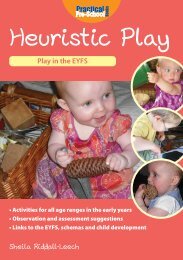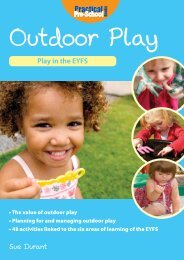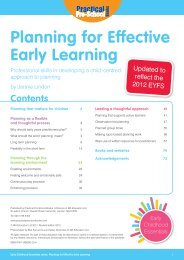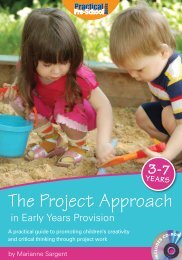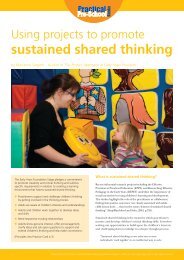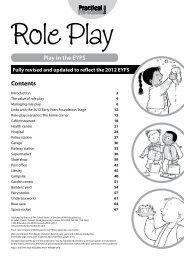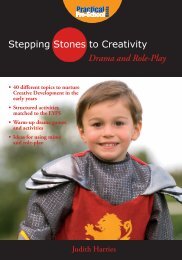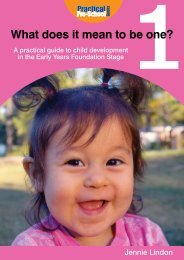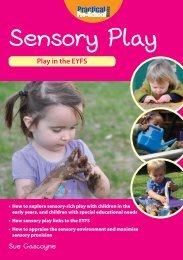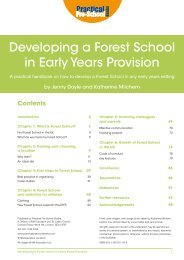What does it mean to be two? - Practical Pre-School Books
What does it mean to be two? - Practical Pre-School Books
What does it mean to be two? - Practical Pre-School Books
Create successful ePaper yourself
Turn your PDF publications into a flip-book with our unique Google optimized e-Paper software.
2<strong>What</strong> <strong>does</strong> <strong>it</strong> <strong>mean</strong> <strong>to</strong> <strong>be</strong> <strong>two</strong>?<strong>Books</strong>A practical guide <strong>to</strong> child developmentin the Early Years Foundation StageREVISED AND UPDATEDJennie Lindon
<strong>Books</strong>REVISEDEDITION2<strong>What</strong> <strong>does</strong> <strong>it</strong> <strong>mean</strong> <strong>to</strong> <strong>be</strong> <strong>two</strong>?A practical guide <strong>to</strong> child developmentin the Early Years Foundation StageJennie LindonContentsFocus on <strong>two</strong>-year-olds 2-9Personal, Social and Emotional Development 10-17Communication, Language and L<strong>it</strong>eracy 18-27Problem Solving, Reasoning and Numeracy 28-33Knowledge and Understanding of the World 34-41Physical Development 42-49Creative Development 50-55<strong>What</strong> should concern you? 56-57Further resources 58-61Acknowledgements 62Published by <strong>Practical</strong> <strong>Pre</strong>-<strong>School</strong> <strong>Books</strong>, A Division of MA Education Ltd,St Jude’s Church, Dulwich Road, Herne Hill, London, SE24 0PB. Tel. 020 7738 5454Revised ed<strong>it</strong>ion © MA Education Ltd 2008First ed<strong>it</strong>ion © MA Education Ltd 2006www.practicalpreschoolbooks.com Illustrations by Cathy Hughes. Front cover image © iS<strong>to</strong>ckpho<strong>to</strong>.com/Rosemarie GearhartAll rights reserved. No part of this publication may <strong>be</strong> reproduced, s<strong>to</strong>red in a retrieval system, or transm<strong>it</strong>tedby any <strong>mean</strong>s, electronic, mechanical, pho<strong>to</strong>copied or otherwise, w<strong>it</strong>hout the prior permission of the publisher.<strong>What</strong> <strong>does</strong> <strong>it</strong> <strong>mean</strong> <strong>to</strong> <strong>be</strong> <strong>two</strong>? (Revised ed<strong>it</strong>ion) ISBN: 978 1 904575 39 9
Focus on <strong>two</strong> year oldsFocus on <strong>two</strong>-year-olds<strong>What</strong> Does <strong>it</strong> Mean <strong>to</strong> <strong>be</strong> Two? explores the developmental needs and likely skills of <strong>two</strong>year-olds.However, <strong>it</strong> makes sense <strong>to</strong> show how <strong>two</strong>s develop w<strong>it</strong>hin their own personaltimeline. So you will also find some examples that include slightly younger children andthe content links closely w<strong>it</strong>h the other three t<strong>it</strong>les in this series, especially w<strong>it</strong>h <strong>What</strong>Does <strong>it</strong> Mean <strong>to</strong> <strong>be</strong> Three? The approach and ideas of this book are relevant <strong>to</strong> anypract<strong>it</strong>ioner, working w<strong>it</strong>h <strong>two</strong>s anywhere in the UK. The structure of the book, however,follows the framework for England of the Early Years Foundation Stage: guidancecovering from birth <strong>to</strong> five years of age that will <strong>be</strong> statu<strong>to</strong>ry for early years provisionfrom Septem<strong>be</strong>r 2008.Children’s learning can only <strong>be</strong> effectively and appropriately supported when adults -pract<strong>it</strong>ioners and parents alike - are guided by sound knowledge of child development. Thelayout of each of the four books in this linked series includes:• Descriptive developmental information w<strong>it</strong>hin the main text, organised w<strong>it</strong>hin thesix areas of learning used by the Early Years Foundation Stage.• ‘For example’ sections giving instances of real children and real places andsometimes references <strong>to</strong> useful sources of further examples.• ‘Being a helpful adult’ boxes which focus on adult <strong>be</strong>haviour that is an effective supportfor children’s learning, as well as approaches that could undermine young children.• ‘Food for thought’ headings which highlight points of good practice in ways thatcan encourage reflection and discussion among pract<strong>it</strong>ioners, as well as sharing inpartnership w<strong>it</strong>h parents.Where are the <strong>two</strong>s ‘officially’?Two-year-olds are competent and, for their age, often articulate learners, so – as their older selvesmight announce – <strong>it</strong> is ‘really unfair!’ that this age group has sometimes <strong>be</strong>en seen as a b<strong>it</strong> of anodd<strong>it</strong>y from the perspective of early years provision. Young children can end up as <strong>two</strong>-year-oldsquare pegs jammed in<strong>to</strong> three- or four-year-old round holes. Potential problems arise from thehis<strong>to</strong>rical spl<strong>it</strong> <strong>be</strong>tween care and education, which has long troubled good qual<strong>it</strong>y experiencesfor children in early years services across the UK. The problem arises <strong>be</strong>cause:• Nursery schools and classes, playgroups and pre-schools developed <strong>to</strong> cater forthree- <strong>to</strong> five-year-olds and came <strong>to</strong> <strong>be</strong> la<strong>be</strong>lled as early education.• Daycare settings and childminders accepted children as young as babies and werelargely seen as carers.The care-education division is <strong>to</strong>tal nonsense from the children’s perspective. Care – or nurture- and learning are inseparable and good early years practice in any kind of provision is alwaysorganised around that central understanding.Unfortunately, official statements and the structure of much inspection have persisted inpresenting the <strong>two</strong> as separate. This approach would matter less if <strong>it</strong> were separate yet equal,but care and caring are so often treated as the poor relation. If adults undervalue care, that<strong>What</strong> <strong>does</strong> <strong>it</strong> <strong>mean</strong> <strong>to</strong> <strong>be</strong> <strong>two</strong>?<strong>What</strong> <strong>does</strong> <strong>it</strong> <strong>mean</strong> <strong>to</strong> <strong>be</strong> <strong>two</strong>?
att<strong>it</strong>ude has a negative effect on the qual<strong>it</strong>y of provision for three- <strong>to</strong> five-year-olds. However, adisrespectful ‘only care’ outlook has even more serious consequences for <strong>two</strong>-year-olds, <strong>be</strong>causethey need demonstrably more caring support.Up <strong>to</strong> 2002 any national guidance across the UK was focussed on the over threes. England,Scotland and Wales each had their own early years curriculum document <strong>to</strong> guide pract<strong>it</strong>ionersworking w<strong>it</strong>h three- <strong>to</strong> five-year-olds. The framework for Northern Ireland covers three- and fouryear-olds,since young children start primary school in the Septem<strong>be</strong>r of the school year aftertheir fourth birthday. Any guidance about good practice w<strong>it</strong>h the under threes was developedw<strong>it</strong>hin a local area by early years teams who were concerned about guiding or enhancing thequal<strong>it</strong>y of provision. Then in 2002 the Birth <strong>to</strong> Three Matters framework was introduced inEngland and in 2005 Scotland launched their Birth <strong>to</strong> Three: Supporting our Youngest Children.The most recent changes 2007-8 are that:• In England from Septem<strong>be</strong>r 2008 the English Birth <strong>to</strong> Three, and the three <strong>to</strong> fiveFoundation Stage, will both <strong>be</strong> replaced by the birth <strong>to</strong> five years framework of theEarly Years Foundation Stage.• In Scotland, the current developments for change revolve around a Curriculumfor Excellence <strong>to</strong> cover from three <strong>to</strong> eighteen years of age. In the earlier years,the main focus for development is for a continu<strong>it</strong>y of more active learning and playfrom the early education of three <strong>to</strong> five years olds in<strong>to</strong> the first years of primaryschool. The Scottish birth <strong>to</strong> three guidance remains unchanged.• In Wales, the main focus of development is on the Foundation Phase for youngchildren from three <strong>to</strong> seven years, bridging the early years curriculum in<strong>to</strong> the firstyears of primary school. There is no national under threes guidance in Wales.• In Northern Ireland the early years curriculum applies <strong>to</strong> three- and four-year-olds,often mainly threes. There is no national under threes guidance and the main focusfor current development is the Foundation Stage that applies <strong>to</strong> the first <strong>two</strong> yearsof primary school, w<strong>it</strong>h children agedfour or five years of age.The English and Scottish under threesmaterials had a different appearance andoverall structure, but otherwise they had agreat deal in common, <strong>be</strong>cause the teamsdrew on the same source materials, includingresearch about very early development.• Both frameworks place astrong emphasis on theimportance of attachmentand of close, affectionaterelationships for youngchildren. They clearly statethat good qual<strong>it</strong>y in groupcare is not possible w<strong>it</strong>houta proper key person system.• Each framework promotes theimportance of a home-likeatmosphere and emphasisesthat good practice w<strong>it</strong>h under<strong>What</strong> <strong>does</strong> <strong>it</strong> <strong>mean</strong> <strong>to</strong> <strong>be</strong> <strong>two</strong>?<strong>What</strong> <strong>does</strong> <strong>it</strong> me<strong>be</strong> <strong>two</strong>?
this younger age range do not really <strong>be</strong>nef<strong>it</strong> from the more complex shape sorter<strong>to</strong>ys. They cannot f<strong>it</strong> shapes in<strong>to</strong> smaller holes and only use the <strong>to</strong>y if there is a lid or<strong>to</strong>p that can <strong>be</strong> removed. Then the <strong>to</strong>y is used successfully as a put-in-and-take-outagainresource.Twos <strong>be</strong>nef<strong>it</strong> from plenty of opportun<strong>it</strong>ies <strong>to</strong> move materials around <strong>to</strong> a purpose – theirpurpose – through building, piling up, putting things in and out, selecting <strong>it</strong>ems that are morelikely <strong>to</strong> f<strong>it</strong>. Their actions, repet<strong>it</strong>ions and variations around their own chosen themes of doingthen provide <strong>mean</strong>ing for simple language about pos<strong>it</strong>ion or any other appropriate concept,which adults have helpfully dropped in<strong>to</strong> the play and conversation.Young children learn a great deal through play but they do not only learn through activ<strong>it</strong>iesthat adults would usually la<strong>be</strong>l as ‘play’. Twos, just like threes <strong>to</strong> fives, are keen <strong>to</strong> <strong>be</strong> involved infamiliar routines. They warm <strong>to</strong> feeling like a trusted helper and genuinely learn from <strong>be</strong>ing par<strong>to</strong>f organising a snack or tidying up the bricks. Sorting out plates and cups, sharing out food andrealising when there is ‘no more’ are all important, practical examples of quant<strong>it</strong>y and reasons forsomeone – more often an adult than a <strong>two</strong>-year-old – <strong>to</strong> count ‘how many’ or assess ‘how much’.For exampleIn Buckingham’s Nursery, pract<strong>it</strong>ioners allow generous time for meals and snacks, <strong>be</strong>cause theseroutines are valued:• The <strong>two</strong>s enjoyed breakfast time w<strong>it</strong>h drink, raisins and breadsticks. The adult used practicallanguage, related <strong>to</strong> the routine, like ‘have you had enough?’ and ‘do you want some more?’Another adult said, at an appropriate moment, <strong>to</strong> one child ‘where do your raisins go?’ andthe child was able <strong>to</strong> answer ‘in my mouth’. During breakfast several children <strong>be</strong>came veryinterested in when they, as individuals, were ‘gone’, by covering their face w<strong>it</strong>h their hands.Numeracy and any use of early mathematical ideas only makes sense w<strong>it</strong>hin a child’s familiarworld, so observational examples that highlight direct experience of early mathematicalunderstanding most usually also show children’s knowledge and familiar<strong>it</strong>y w<strong>it</strong>h their own worldFor exampleYou might like <strong>to</strong> consider how the examples in this section also contribute <strong>to</strong> your understandingof these young children’s skills in any other of the six areas of learning and development.• Two-year-old Gary moved around the Windham drop-in w<strong>it</strong>h confidence. Sometimes hismother was close by, sometimes he was absor<strong>be</strong>d in play and she was across the room. Garymoved <strong>be</strong>tween the opportun<strong>it</strong>ies that were available. He spent some time w<strong>it</strong>h the markmakingmaterials set out on a table. He was equally interested <strong>to</strong> explore letting a wheeled <strong>to</strong>yrun down a slope <strong>to</strong> his mother. He spent time emptying a container of keys, exploring manyof them individually – looking and feeling.• In Buckingham’s Nursery I observed <strong>two</strong> children (in their <strong>two</strong>s) who persisted in taking thebowl in and out of the wooden play sink. They explored moving the bowl around, trying <strong>to</strong> f<strong>it</strong><strong>What</strong> <strong>does</strong> <strong>it</strong> <strong>mean</strong> <strong>to</strong> <strong>be</strong> <strong>two</strong>?<strong>What</strong> <strong>does</strong> <strong>it</strong> me<strong>be</strong> <strong>two</strong>?




